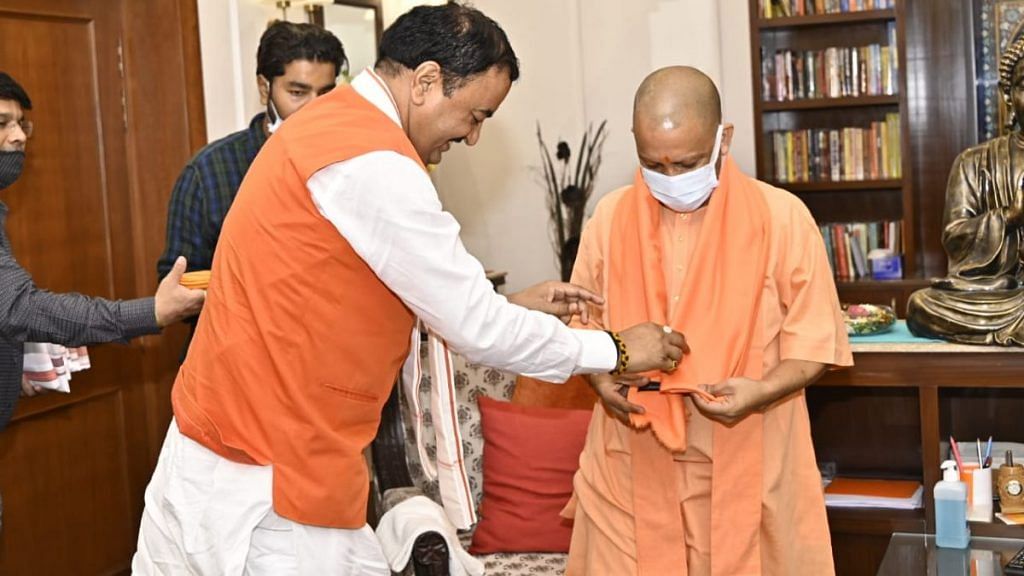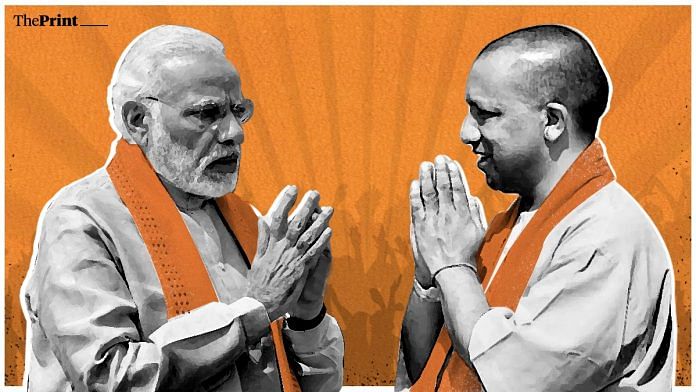New Delhi: Uttar Pradesh Chief Minister Yogi Adityanath was quite active on Twitter over the last two days. He thanked the PM for an agricultural loan scheme, he wished Union Finance Minister Nirmala Sitharaman on her birthday, he posted updates about his activities.
But he maintained a deafening silence about one crucial matter: the BJP’s reshuffle of its parliamentary board this Wednesday.
Within 48 hours of the party announcing its reconstitution of the key decisionmaking board, all the BJP chief ministers tweeted their congratulations.
The list included Madhya Pradesh Chief Minister Shivraj Singh Chouhan (who had just faced the sting of being dropped from the board), Assam’s Himanta Biswa Sarma, whose rival, former CM Sarbananda Sonowal, was one of the new inductees, and Karnataka’s Basavaraj Bommai, who reportedly even paid a personal visit to congratulate his “mentor” B.S. Yediyurappa on his induction.
The only one who kept mum was Yogi Adityanath.
An Uttar Pradesh minister, who is known to be close to Yogi, told ThePrint: “He has not been open about his emotions yet, but everybody expected him to be inducted into the parliamentary board. In fact, forget about the parliamentary board, he is not part of any decisionmaking body — not even the election committee.”
There are no chief ministers in the 11-member board, with the BJP high command also dropping the one CM, Chouhan, who was on it. It has been speculated that the reason this was done was so that Yogi could also be kept out.
This decision, according to some BJP insiders, reflects an escalating deficit of trust between Delhi and Lucknow.
There is a widespread perception that the BJP high-command wants power to be concentrated in Delhi, and does not wish for popular chief ministers, especially Yogi, to get too big for their boots ahead of the 2024 Lok Sabha elections.
“It was shown that Yogi is only equal to other CMs,” a BJP leader said. He added that while there was tension over the matter, it had not reached a “threatening level”.
When asked whether Yogi was deliberately sidelined, senior BJP leader and Rajya Sabha MP from UP Ashok Bajpai said this was not the case.
“No other post is as significant as being the chief minister of India’s largest state (sic). Yogi is just 50, he has age on his side. Whether he is on the board or not does not matter. It is also a fact that no chief minister is on the board — the party has to think beyond individuals to keep geographical representation in mind,” Bajpai said.
In the BJP’s internal politics, Yogi has of late been in a somewhat delicate position, with some of his detractors becoming more vocal.
For instance, the day before the parliamentary board was reconstituted, a video went viral of Deputy Chief Minister Keshav Prasad Maurya singing the praises of BJP national general secretary Sunil Bansal and crediting him with the party’s 2017 win in UP.

This is significant because Maurya is known to have the ear of Union Home Minister Amit Shah and was inducted into the Yogi cabinet even though he lost the election. Bansal, too, is close to Shah and had a strained relationship with Yogi back when he held key party positions in UP.
Therefore, it did not go unnoticed when Maurya, speaking in the presence of Yogi at a function, said that the “real hero” of UP was Bansal and credited him with taking the BJP from “shunya se shikhar (zero to summit)” in the state.
This, together with the parliamentary board reconstitution, is interpretable as a coded putdown from the top, even as Yogi loyalists insist that nothing can keep their leader down.
Also read: Shivraj Singh Chouhan to Yediyurappa, here’s the message from BJP parliamentary board reshuffle
‘Yogi’s fight for Delhi will begin in 2027’
Several BJP leaders in UP are smarting over Yogi’s exclusion from the parliamentary board, but many are convinced that it is only a matter of time before he becomes a national-level leader, much as Narendra Modi went from Gujarat CM to the country’s PM.
“It was a shock. Everyone thought Maharajji would be brought into the board. He is the CM of the largest state in India (sic), he has formed a BJP government twice here [in 2017 and 2022], he is the Hindu hriday samrat (king of Hindu hearts) after Modiji,” a BJP MP from UP said.
He added that several of the senior leaders on the board would have been better suited as “governors”, but said that Yogi was in no hurry.
“His fight for Delhi will begin in 2027. Until then, he has time to create his image as a no-nonsense man who is focused only on development,” the MP said.
A second minister in the Yogi cabinet also said the CM’s priority should be to deliver good governance and bolster his pro-industry image, so that he could build a “larger-than-life” image for the future.
“Tell me, who is safe today among the chief ministers? Everyone knows that continuously winning elections is the first criterion to save the chair. The immediate challenge before Maharajji is to win more than 60 seats (out of 80) anyhow in the 2024 Lok Sabha elections. Otherwise, he will be in the danger zone.”
BJP MP from Kanpur, Satyadev Pachauri, who served as a minister in Yogi’s first cabinet, said that too much should not be read into the parliamentary board selection.
“Ultimately, we get votes in Modi’s name. Who is in the board and who isn’t, does not matter. It is only relevant for the BJP’s internal politics. They might have considered several factors before reconstituting the board,” Pachauri said.
Tensions between Lucknow and Delhi
Over the last couple of months, certain developments have hinted that Yogi and the BJP high-command are not in perfect alignment.
In July, Dinesh Khatik, junior Minister for Water Resources in the Yogi cabinet, offered to quit his post, claiming that department officials ignored him, he was not given work, and that he felt discriminated against as a Dalit.
He also claimed there was corruption in transfers and postings. The catch was that he sent the letter straight to Amit Shah, rather than to Yogi, or the BJP president, or even to his own senior minister Swatantra Dev Singh.
Khatik ended up withdrawing his resignation soon afterwards and said all issues were “resolved”, but not before the letter was shared widely on social media.
Just weeks before this, Brajesh Pathak, who is the co-Deputy CM with Keshav Maurya and also holds the health portfolio, expressed his displeasure over the transfer of doctors in a letter to the additional chief secretary (health), Amit Mohan Prasad.
The transfers had purportedly been ordered at the behest of the Chief Minister’s Office (CMO). In this instance, too, the internal communication went viral. BJP insiders said that Delhi leaders had to help in sorting out the issue between the CM and his deputy.
Another fracas, in July, was when UP Public Works Department (PWD) Minister Jitin Prasada reportedly went to Delhi to complain when his Officer on Special Duty (OSD) was removed and five others were suspended, following allegations of irregularities in the transfers and postings of engineers.
“The removal of the OSD on charges of corruption was done to embarrass Jitin Prasada and Delhi… after all, Jitin Prasada’s induction was held at Delhi and his plum portfolio was decided by Delhi,” a second BJP MP said. Jitin Prasada had quit the Congress and joined the BJP in 2021.

Yogi’s camp is convinced that the rifts in the cabinet have been engineered to embarrass him.
The second BJP MP added: “Do you think that any minister can air such grievances against a towering CM like Yogi Adityanath if they were not given support from Delhi? It shows that Delhi wants checks and balances to restrict Yogi, so he does not become like Kalyan Singh or Yediyurappa.”
While Kalyan Singh, a “Hindu hriday samrat” of yore had locked horns with Atal Bihari Vajpayee and tried to take on the role of a challenger in the 1990s, former Karnataka CM Yediyurappa had quit the party in 2012 and even floated a regional party to eat into the BJP votes in 2013, leading to its defeat (a merger followed in 2014).
Speculation that the BJP high-command has been trying to temper Yogi’s ambitions is not new.
Even ahead of the 2022 assembly elections, several observers noted that it was a subtle snub for Yogi that the party had decided that he should contest from Gorakhpur rather than Ayodhya or Mathura, which are among the most important Hindu religious centres in the country.
According to party insiders, this decision was taken since it was felt that fielding Yogi might dilute Modi’s status as the “Hindu hriday samrat”.
There is also a perception that the BJP high-command has made sure to install members of its own trusted circle in UP’s political and bureaucratic circles to keep a curb on Yogi.
Examples of this are said to include the decision, ahead of the polls, to repatriate Union housing secretary Durga Shankar Mishra to his home cadre as UP chief secretary just before he was due to retire. This was done when the then serving chief secretary R.K. Tiwari, who had a good equation with Yogi, wasn’t due for retirement until 2023.
Then there was the case of retired bureaucrat A.K Sharma, often described as a “Modi man”. After leaving service early in 2021, he entered politics and was quickly made party vice-president in UP. A member of the UP legislative council, he took oath as a minister in the Yogi cabinet this year.
“Instead of being reinstated in some regulatory body in Delhi, Sharma was sent to UP. It only shows Delhi wants to micromanage things,” a BJP functionary said.
(Edited by Asavari Singh)
Also read: Rumblings in Yogi 2.0: MoS sends resignation to Amit Shah, two other ministers unhappy






